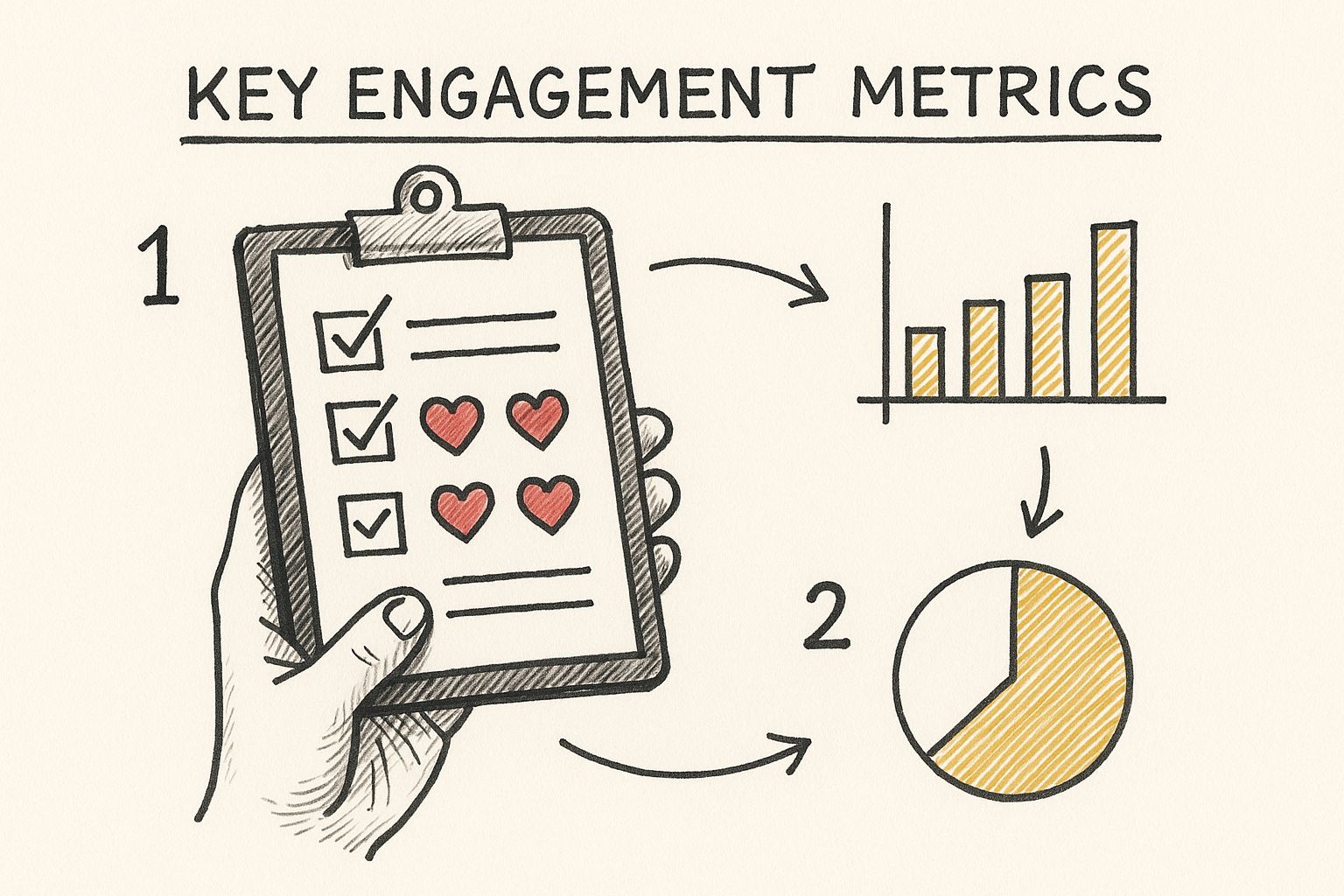Mastering Measuring Employee Engagement Effectively

Measuring employee engagement isn't just an HR function anymore—it's a core business strategy. We've moved past simple happiness tracking. Now, it’s about diagnosing the health of your entire organization and uncovering insights that directly influence productivity, retention, and innovation. That’s why sharp leaders now consider it a non-negotiable part of performance management.
Why Measuring Engagement Is a Business Imperative

Let's be clear: the conversation around employee engagement has fundamentally shifted. It's no longer a "nice-to-have" perk but a C-suite priority, and for good reason. Disengagement carries a real, measurable economic cost that leaders can no longer afford to ignore.
According to Gallup's 2024 State of the Global Workplace report, low employee engagement costs the global economy an estimated $8.9 trillion annually. That figure represents 9% of global GDP. This isn't a static problem, either; that figure climbed by nearly $1 trillion from the previous year's report, indicating a worsening global challenge.
Moving Beyond Simple Satisfaction
To really get a handle on this, it's critical to understand what employee engagement means and why it’s such a powerful business asset. It’s not just about keeping people happy or satisfied, though those are often nice side effects. True engagement is the emotional commitment and psychological investment an employee has in their organization and its success.
Engaged employees don't just work for a paycheck; they work with a sense of purpose and passion. They're the ones who innovate, take ownership, and push the business forward, often without being asked.
This distinction is everything because it connects directly to tangible business outcomes. Engaged teams are more resilient, more productive, and deliver a much higher quality of service. For any organization serious about thriving, getting this right is the first step toward building a high-performance environment.
The Strategic Value of Measurement
Measuring employee engagement gives you a powerful diagnostic tool. It lets you pinpoint specific issues before they spiral into bigger problems, like high turnover or a nosedive in productivity. Think of it as a regular health check-up for your company.
A systematic approach to measurement delivers some key benefits:
- It spots at-risk teams. You can see which departments or managers are struggling, which allows you to offer targeted, effective support.
- It informs strategic decisions. Leadership can use solid engagement data to guide choices on everything from benefits packages to leadership development programs.
- It builds a culture of trust. When employees see that their feedback is not only collected but acted upon, it builds tremendous trust and reinforces that their voices actually matter.
Without data, you're just operating on assumptions. By systematically measuring engagement, you replace guesswork with evidence-based insights. This is how you build an intentional and effective strategy. More importantly, a strong measurement program is the foundation for creating a true culture of engagement where people feel genuinely valued and connected to their work.
Building Your Engagement Measurement Framework
Let's get one thing straight: a powerful employee engagement strategy isn't something you can just copy and paste. It starts with a measurement framework that’s built specifically for your organization—one that reflects your unique goals, culture, and how you actually operate. The first step, before you even think about questions, is to define what genuine engagement looks like for your teams. We need to move past fuzzy ideas and get down to the concrete behaviors and outcomes that signal a thriving workforce.
An effective framework is more than just a single annual survey. It's about blending different types of data to create a complete, almost three-dimensional view of your organization's health. To make this happen, it often helps to use comprehensive HR platforms like SAP SuccessFactors Employee Central as a central hub. Integrating your data this way is what allows you to see the big picture instead of just isolated snapshots.
Defining Your Core Metrics
To really understand what’s going on, you need to track both quantitative data and crucial behavioral indicators. Think of it like a doctor's visit: you get your vitals checked (the numbers), but you also talk about how you're feeling (the context). Both are essential for a proper diagnosis.
Your metric mix should include:
- Quantitative Survey Data: This is the foundation for most engagement programs. You’ve got metrics like the Employee Net Promoter Score (eNPS), which gives you a quick read on loyalty. Then you have your structured survey questions that dig deeper into specific drivers, like whether people feel recognized or see a path for career growth.
- Behavioral Indicators: These are the real-world actions that often speak louder than words. Keep a close eye on your voluntary turnover rates and employee absenteeism rates. A sudden spike in either of these is a classic red flag for disengagement.
- Productivity Data: It’s no secret that engaged teams get more done. While productivity isn't a direct measure of how people feel, you can uncover some incredibly powerful insights by correlating performance data with your survey results. This is where you connect the dots between sentiment and output.
This image really drives home how these different pieces come together in a continuous process.

As you can see, measuring engagement is dynamic. It’s a loop that combines direct feedback from things like surveys with observational data from performance and retention metrics to give you a truly holistic view.
Choosing the Right Measurement Cadence
How often you check in with your employees is just as important as what you ask them. The right frequency, or cadence, comes down to your organization's ability to act on the feedback and what you're trying to achieve strategically. There's no one-size-fits-all answer here, and honestly, the best approach is often a mix of methods.
Choosing a measurement cadence isn't just a logistical decision—it's a cultural one. A commitment to more frequent listening signals to employees that their feedback is a continuous and valued part of the organizational dialogue, not just a once-a-year event.
Deciding on a survey frequency can feel daunting, so here's a table to help you compare the most common approaches and see which might be the best fit.
Choosing Your Engagement Measurement Cadence
| Method | Frequency | Scope | Best For |
|---|---|---|---|
| Annual Survey | Once a year | Comprehensive deep-dive across multiple engagement drivers. | Establishing a solid, company-wide baseline and tracking long-term strategic shifts. |
| Pulse Surveys | Quarterly or monthly | Short, focused surveys on 2-5 key topics. | Tracking progress on specific initiatives and getting a real-time feel for team sentiment. |
| Continuous Listening | Always-on | Real-time feedback channels (e.g., embedded in emails, kiosks). | Organizations with a mature feedback culture that can act quickly on incoming insights. |
Ultimately, the goal is to create a sustainable rhythm of feedback and action. For most organizations, a great place to start is with a comprehensive annual survey supplemented by quarterly pulse surveys. This hybrid model gives you both the big-picture strategic view and the quick, tactical insights you need to make timely adjustments. It’s this combination that ensures your efforts lead to real, sustainable change.
How To Craft Surveys That Get Honest Answers
If you want honest answers, you have to ask the right questions. The data you pull from any employee engagement effort is a direct reflection of the quality of your survey. This is where many companies stumble—they grab a generic template, hit send, and then wonder why the results are so bland.
Real insight comes from digging into the things that actually drive engagement. I’m talking about leadership effectiveness, a real path for personal growth, and feeling genuinely recognized for your work. A well-designed survey isn't just a data collection tool; it’s a powerful instrument for gathering intelligence. Let's look at how to build one that gets you the truth.
Balancing Question Types for a Complete Picture
Think of building a survey like a painter choosing their brushes. You wouldn't use one giant brush for an entire masterpiece, right? You need a mix of tools to capture the full scene. Relying on a single question format will give you a skewed, incomplete view of your company culture.
Here’s a practical mix that has proven effective:
- Likert Scale Questions: These are your bread and butter. Using a scale like "Strongly Disagree" to "Strongly Agree" for statements such as, "My contributions are valued by my manager," is perfect for measuring sentiment and spotting trends over time. This is how you benchmark your progress.
- Open-Ended Questions: Here's where you find the gold. A simple prompt like, "What’s one thing we could do to improve your experience here?" can uncover brilliant ideas or simmering frustrations you never would have thought to ask about. This is your "why."
- Employee Net Promoter Score (eNPS): Want a quick, powerful pulse check on loyalty? The eNPS is your go-to. It all boils down to one question: "On a scale of 0-10, how likely are you to recommend our company as a great place to work?" Its simplicity makes it incredibly easy to track.
When you blend these formats, you get the "what" from the quantitative data and the "why" from the qualitative feedback. This two-pronged approach is non-negotiable if you're serious about understanding and improving engagement.
Formulating Questions That Drive Action
How you word your questions changes everything. If a question is ambiguous, leading, or loaded, you might as well throw the data out. The goal is to be crystal clear, neutral, and focused on tangible experiences.
For instance, "Is leadership effective?" is a useless question. It's far too broad. Instead, get specific and break it down:
- "My manager provides me with constructive feedback that helps me improve."
- "I have confidence in the vision and direction set by our senior leaders."
See the difference? Now you have actionable feedback. If scores on the first question are low, you know exactly where to focus your efforts: training managers on how to give better feedback.
One crucial piece of advice: Only ask about things you are actually willing to change. Asking for feedback on an issue you can't or won't address is the fastest way to destroy trust and breed cynicism.
Why Your Survey Is More Than Just a Survey
It's important to remember that a survey is just one part of a much larger conversation. Your results are a snapshot of your workforce, and right now, the global picture shows there's a lot of room for improvement.
The 2024 Gallup State of the Global Workplace report found that only 23% of employees worldwide are actively engaged at work. That leaves a massive 77% who are either not engaged ("quietly quitting") or actively disengaged.
The research points to a few common culprits behind this disengagement, like a lack of development opportunities or employees simply not feeling valued. This context is vital. It proves that your questions about growth and recognition aren't just filler—they tap into the core issues holding back engagement on a global scale.
Dive into the full findings on employee engagement statistics to see how these global trends might be playing out in your own organization. Understanding this bigger picture will help you put your survey results into perspective and build a smarter action plan.
Turning Engagement Data Into Actionable Insights
Collecting data is just the first step. The real magic happens when you turn all those raw numbers and comments into a clear game plan for making things better. Once your surveys are closed, the real work begins—digging into the results to find the stories your employees are telling you.
Your goal isn't just to get a single, flashy engagement score. Frankly, that number doesn't tell you much on its own. The most powerful insights come from slicing the data. Think about it like a business review: you wouldn't just look at total revenue, right? You'd break it down by product line, region, and sales team. Apply that same thinking here. Analyze your results by department, by employee tenure, or even by office location to find specific hotspots of friction or success.
From Numbers to Narratives
It’s easy to get lost in the spreadsheets and forget what the numbers actually represent. A low score is a symptom, not the disease. Your job is to play detective and figure out the root cause. If you're looking to really master this, there's a complete guide to data analysis for survey success that offers some great techniques for getting to the heart of what your employees are saying.
Once you start segmenting, you'll uncover patterns you'd otherwise miss. For example, you might discover that:
- High turnover in a specific department aligns with low scores on questions about manager support.
- New hires (0-6 months) are enthusiastic and engaged, but that excitement plummets after their first year, hinting at a problem with career development or long-term growth.
- Remote employees consistently report feeling disconnected from company news, which tells you your current communication channels aren't working for everyone.
These are the kinds of specific, actionable insights that let you move past generic "engagement initiatives" and start solving real problems for real people.
This isn't just a trendy corporate practice; it's a strategy proven at the highest levels of government. A landmark OECD report on public sector employment showed how organizations use systematic surveys and detailed benchmarking—all the way down to the team level—to empirically link employee engagement with performance and innovation. The report’s main warning? Just measuring employee engagement isn't enough. Real improvement only happens when leaders commit to acting on what they find. You can read the full report on public employee engagement strategies to see how these principles are applied on a massive scale.
Unlocking the Power of Qualitative Feedback
While your quantitative data tells you what is happening, the open-ended comments tell you why. This qualitative feedback is pure gold, but manually sifting through thousands of comments is a nightmare. This is where modern tools can be a game-changer.
Platforms like MyCulture.ai use AI to instantly process all that written feedback. The technology can perform sentiment analysis to gauge the emotional tone of the comments and automatically identify the most common themes. This saves hundreds of hours of painstaking manual work. You can see, in seconds, whether the prevailing sentiment around "leadership" is positive or negative and discover the exact words people are using to describe it.
This screenshot from MyCulture.ai shows how a platform can make sense of complex cultural data visually.
A dashboard like this immediately turns abstract ideas like company values and behaviors into clear, measurable metrics, making it far easier to spot strengths and weaknesses at a glance.
Ultimately, the best approach combines your hard numbers with AI-powered analysis of the qualitative feedback. This gives you a complete, compelling story. You'll understand not just the current state of your organization but also the underlying cultural dynamics driving it. For a deeper dive into structuring this entire process, you might find our guide on conducting an organizational culture assessment helpful. It ensures your action plan is built on a solid, nuanced understanding of your people.
From Insight To Impact Through Action And Communication

You’ve done the heavy lifting of collecting and analyzing the data. Now comes the part where all that work in measuring employee engagement actually pays off. The journey from insight to impact is all about deliberate action and open communication. Failing at this final, critical stage is a common reason engagement initiatives fall flat and breed a deep, lasting cynicism among employees.
This is your moment to close the feedback loop. You get to prove to your people that you didn't just hear them—you listened, and their voices have the power to create real change. This follow-through is what elevates a simple survey into a catalyst for a healthier, more connected workplace.
Embrace Radical Transparency
The very first thing you should do after analyzing your results is share them. Yes, all of them. This can feel daunting, especially if the feedback is tough to swallow, but hiding or sugarcoating the findings is a fatal mistake. If you want to build trust, you have to be radically transparent.
Start by sharing the high-level results with the entire organization. Celebrate what’s going well and be upfront about the challenges. This simple act shows you respect your employees and signals that you're all in this together. Research on workplace trust consistently shows that a lack of transparency erodes it faster than almost anything else.
After the all-hands communication, it’s time to drill down. Make sure managers get their specific team results. The point isn't to point fingers; it's to empower them with the data they need to understand their team's unique experience.
Empower Managers to Drive Change
While senior leadership sets the tone, the real, tangible change happens at the team level. Your managers are the most critical link in this entire process. Think about it: research from Gallup has repeatedly shown that managers account for as much as 70% of the variance in employee engagement scores across business units. Equipping them to act on the data isn't just a good idea—it's non-negotiable.
To set them up for success, you absolutely must provide them with:
- Clear Reports: Give managers easy access to their team's specific data, presented with context and simple visualizations that they can actually use.
- Facilitation Guides: Offer practical resources and talking points to help them lead productive, psychologically safe conversations with their teams about the results.
- Action Planning Templates: Provide simple, straightforward tools to help them and their teams brainstorm and co-create solutions to their specific challenges.
The goal here is to shift the sense of ownership from HR to the teams themselves. When people are involved in creating the solution, their commitment to making it work skyrockets. This subtle shift moves the focus from "HR's survey" to "our team's improvement plan."
When you simply ask employees for their opinion and do nothing with the feedback, you do more harm than good. A successful program requires that managers are ready and equipped to act before you even launch the survey.
Co-Create Solutions and Establish Feedback Loops
Let’s be clear: effective action planning is not a top-down directive. It’s a collaborative workshop. It’s a conversation where managers and their teams can openly discuss the feedback, agree on one or two key areas to focus on, and brainstorm solutions together. This co-creation process is absolutely vital.
For example, if a team’s scores for "recognition" are in the basement, they might decide to implement a simple weekly shout-out system in their team huddle. If "career growth" is the sticking point, the manager might commit to scheduling dedicated development conversations with each team member over the next quarter.
Once a plan is in place, the work isn't over. You have to establish a continuous feedback loop to track progress and maintain momentum.
- Regular Check-ins: Action items should become a standing topic in one-on-ones and team meetings. Is what we're doing working?
- Pulse Surveys: Use short, targeted pulse surveys a few months later to see if the new initiatives are actually moving the needle on sentiment.
- Visible Tracking: Keep the progress on action items visible. A shared digital board or a quick update in a team newsletter can help maintain accountability.
This consistent follow-up proves that the survey wasn't a one-off event but the start of an ongoing conversation. It shows a genuine commitment to continuous improvement and solidifies the value of measuring employee engagement as a core part of your company's rhythm.
Common Questions About Measuring Employee Engagement
Even with a solid plan in place, leaders often have a few lingering questions before they dive into measuring employee engagement. Let's clear up some of the most common ones so you can move forward with confidence.
How Often Should We Survey Employees?
There’s no magic number here—it really comes down to what you’re trying to accomplish.
An annual, deep-dive survey is fantastic for establishing a solid baseline. It gives you that comprehensive, big-picture view you need for long-term strategy. But if you wait a full year between check-ins, you're missing out on a lot of timely insights.
That’s where pulse surveys come in. Sending out shorter, more frequent surveys—maybe quarterly or even monthly—lets you keep a finger on the pulse of the organization. You can see how people are feeling in near real-time and quickly gauge the impact of a new initiative. Many successful companies use a hybrid model: one big annual survey, supplemented by regular pulse checks. It truly offers the best of both worlds.
What Is a Good Employee Engagement Score?
Everyone wants to know the magic number, but the truth is, a "good" score is one that's getting better. Your own internal trend line is the most powerful story you can tell. Seeing your engagement score tick up from one quarter to the next is a far more meaningful sign of success than hitting some generic industry number.
Of course, external benchmarks from places like Gallup or your survey provider can be useful. They add context and show you how you compare to others in your field. Just don't get obsessed with them. Focus on your own journey of improvement first.
How Do We Guarantee Anonymity?
This one is critical. If your team doesn't trust that their feedback is truly anonymous, you won't get honest answers. It’s as simple as that.
The best way to ensure confidentiality is to use a trusted third-party platform, like MyCulture.ai, which is built to aggregate data anonymously. You have to be upfront and crystal clear in your communications, explaining exactly how the data is collected, protected, and reported back in grouped, unidentifiable formats.
A hard and fast rule we always follow: never report on a data segment so small that an individual could be pinpointed. For example, if you have a team of only three people, you shouldn't be drilling down into their specific results. Trust is everything, and it’s what ultimately drives participation in surveys and other workplace culture activities.
Ready to move beyond guesswork and build a thriving, engaged workforce? MyCulture.ai provides the tools to measure what matters, turn insights into action, and foster a culture where everyone can succeed. Explore our platform today.